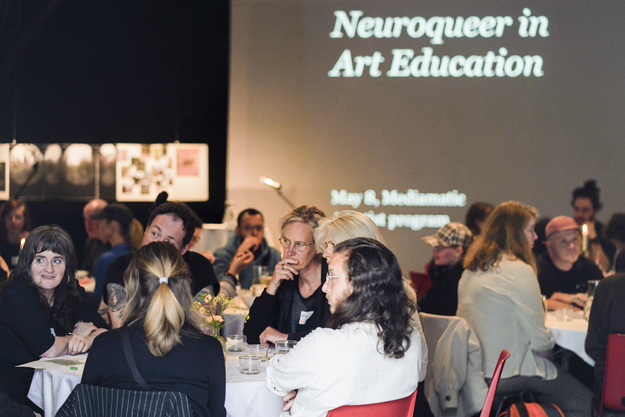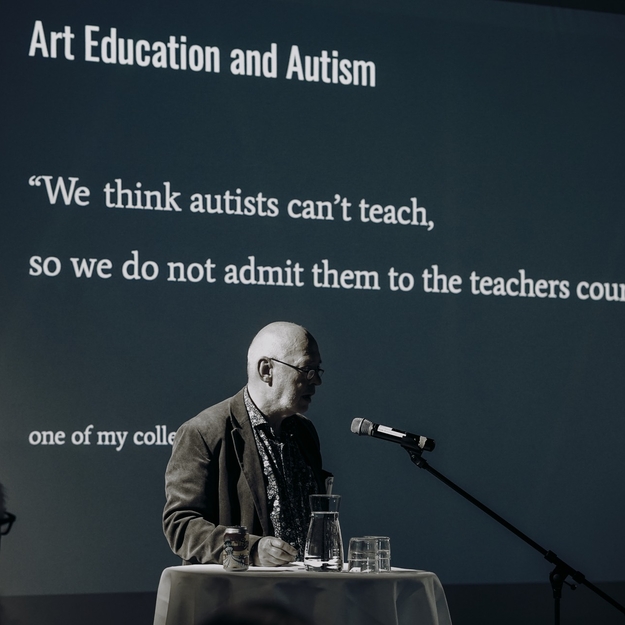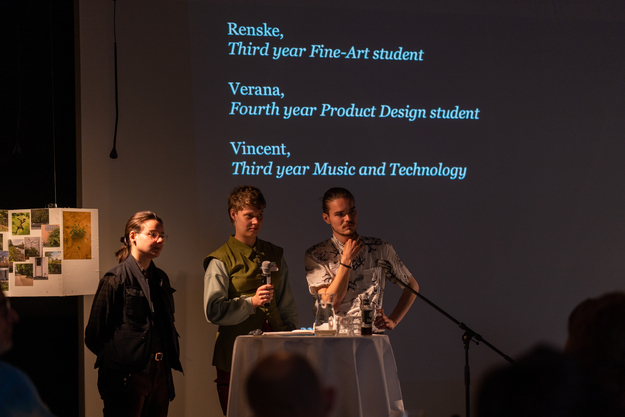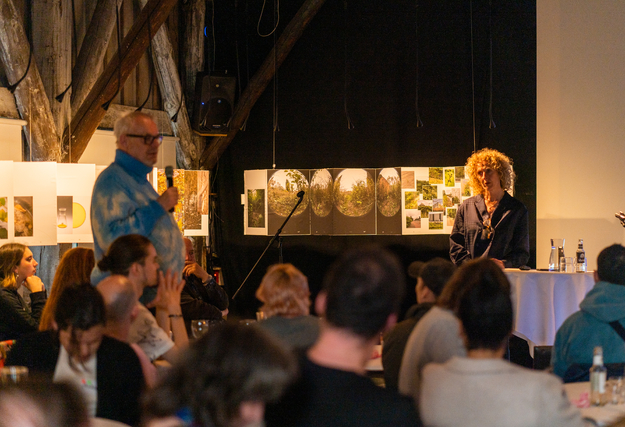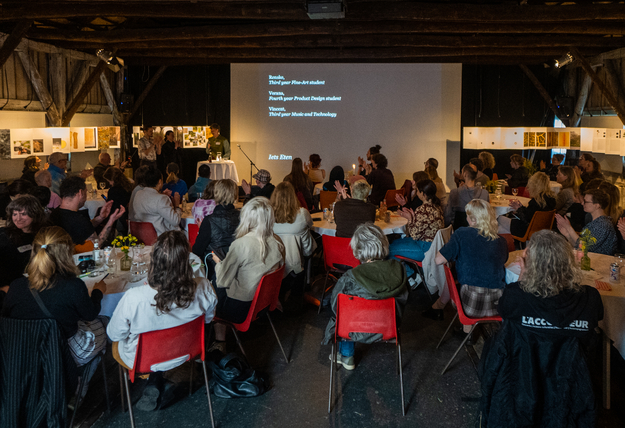We started off the evening with welcoming words by Mediamatic’s director and co-founder of the A/artist program Willem Velthoven and HKU’s recently retired autism ambassador Gerard van Wolferen, who were both instrumental in realising this get-together.
Welcome by Willem
“When I was twelve years old, I read about autism in the newspaper“, Willem began. “So I asked my father: Can I become and autist, too?“ Fifty years have passed in the meantime, with various ups and downs, which eventually led Willem to receive his autism diagnosis at age 63.
Even before that, Mediamatic’s policy plan for the coming years was titled autistisch verkennen - autistic exploration. “The dream at some point in the future is to turn Mediamatic into an atheist autistic monastery“, Willem disclosed confidentially - “But today, our focus is on art education. One in ten students in art school is autistic, that’s a disproportionately high number. But even in art school all of us pretend to be normal, and it’s hard to find each other. So that’s our goal for tonight: to find each other and to organise.“
“You are all here to help with that - “, he addressed the room. “ So thank you!“
Welcome by Gerard
Next, Gerard van Wolferen introduced himself and the initiative he brought to life at his school, HKU, together with colleague Claudia van den Hoeven. Together, they organised a series of regular get-togethers for autistic students they simply called iets eten (“eat something“), which have since evolved into a warm and welcoming community.
Gerard worked as an educator in the School of Music and Technology at HKU for many years before recently going into retirement. He shared that he received his own autism diagnosis thirteen years ago, but only made it public at his school after hearing a colleague remark that “autists can’t teach“.
These kinds of prejudiced statements lead him to step up and make his diagnosis public, and taking on the role of autism ambassador.
“My motto is that autism is a normal part of human diversity“, Gerard said. “And I hope that many of you can agree with that.“
He created the iets eten group together with his colleague Claudia in order to show autistic students at HKU that they are not alone in their experiences. “There’s a special atmosphere when autistic people come together“, he said. “It’s a kind of empathy and openness that makes for a very nice environment for the students and also for me.“ Having such a community then also makes it possible to step up and advocate for the cause. The joint goal of iets eten and the A/artist program, he said, is to improve art education for autistic students, making the schools aware of who they are, how they think, feel, and work, and what they can do. He also defined a few goals for this evening specifically: to get to know each other as artists, students and educators, join the new A/artist Discord server and stay connected, and start thinking about how to reach out to neurodivergent students at different schools in order to organise communities similar to iets eten there.
Small roundtables
After these introductions, it was time for dinner and an adapted version of the traditional A/artist roundtables. Guests were seated around round tables in the Sleusdeurenloods, and now had the opportunity to get to know each other over a bowl of delicious lentil soup.The A/artist team had printed out guiding questions for discussion:
- At your art school, are/were there any initiatives to support the neurodivergent student community
- Do you feel that the support you received is/was good enough? How could it be improved?
- What current opportunities are there for neurodivergent students to have their voices heard by your institution?
- How can educators help to support neurodivergent students?
And A4 paper and pens were provided on each table to record thoughts. Of course, people could decide to use this resource or alternatively just focus on the discussion.
A/artist symposium - Anna Lina writing notes -
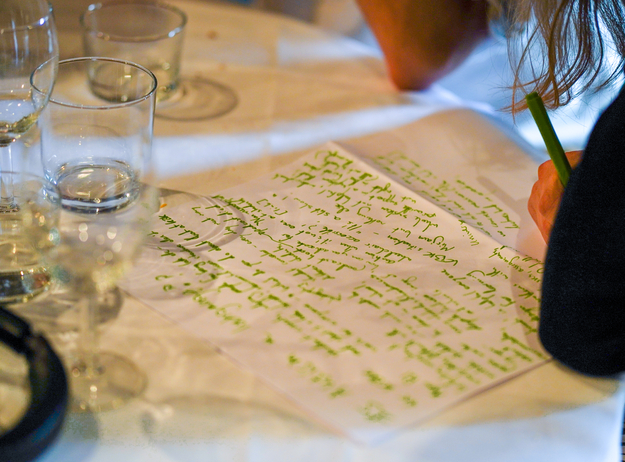
Student experiences
Next up, three of the students from the iets eten group shared their experiences and what the community has meant to them over the past years.
“A soft hug or a firm hug?“
Verana, a 4th year student of product design, said that she completed half of her studies without, and the second half with iets eten. During the Covid-19 pandemic, she lost connection to her classmates, but found community with the iets eten group instead.
She shared a fond memory: coming into the room still very overstimulated from her train journey, she opened up to the group and was met with a lot of understanding. “It’s a warm memory about being able to be open and not ashamed about this stuff“, she said. Someone even asked if she wanted a hug, and specified: “A soft hug or a firm hug?“ - “So then I thought okay, you know the right questions to ask.“ Iets eten is a space where you can feel very heard and participate well, Verana said. “It’s a community, there are always fun new people and it’s a safe haven. It also doesn’t matter if you’ve missed sessions before.“
“I think my work is always slightly about autism, but most people didn’t see that“
Then we heard from Renske, a 3rd year Fine Art student. Renske joined iets eten one year ago after it was recommended to her by a tutor. “At first it didn’t sound that good, but I tried it anyway and it was the most welcoming space.“, they said. They also reflected on how iets eten helped them develop their work. “I think my work is always slightly about autism, but most people I showed it to, including my teachers, didn’t see that. But when I showed to the iets eten group, they found something completely different in it.“
Concluding, Renske described the experience of iets eten as one of recognition, joy and new insights into their own art. They were also excited to become a student autism ambassador and join one of our recent A/artist roundtables, as they are excited to also connect with autistic artists already working as professionals in the art world.
A/artist symposium - Renske shares experiences with 'iets eten' -
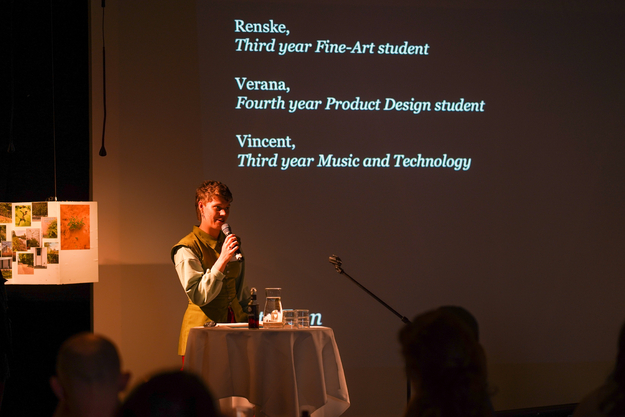
“It’s calming to be around like-minded people“
The last student to share his experience was Vincent, who studies Music and Technology in his 2nd year. “I’m still a bit overstimulated from the way here“, he started out, “But I think what’s great about this kind of space is being okay with sharing that because the people here understand.“
He shared that joining iets eten has helped him to become more open and self-accepting. He learned a lot from the different speakers that have been invited to the sessions, and even gave a talk himself about knowing oneself and one’s limits. “It’s calming to be around like-minded people“, Vincent said. “Initially you think you’re the only one in the whole school, and it’s easy to think I’m weird, or I can’t fit in, so it’s important to find community.“
Q&A with the students
Next, the students opened the floor for questions.
“What happens after graduation? Will you also remain a community then?“, someone asked.
Verana responded saying that she doesn’t want to lose the iets even community after her upcoming graduation, and that the students intend to keep it going beyond graduation and build a network, making sure that alumni are always welcome to come back and join sessions.
“What does being a student autism ambassador include?“, another guest asked.
“It means being visible, and available for questions and concerns“, Renske answered. “A student ambassador is someone new students can approach, we also work as a gateway to iets eten.“
“Did your group grow over time?“, someone else wanted to know. The students explained that at the moment about fifteen to twenty people attend each session, but there are more than forty members in the WhatsApp group, and there is absolutely no pressure to join meetings in person - you are still part of the community if you don’t. “But we want more people!“, Renske added.
Another guest asked: “Is it enough to just create this space and let people come, will a community automatically emerge from that?“
“Iets eten is awesome because the people are“, Renske said, and added that the imposed structure of bimonthly meetings is very helpful: “It’s reliable because it’s organised by Claudia and not student-run, so it’s out of our hands“, they added. “More and more people are now becoming enthusiastic about the vibe of the group, so it becomes a peer-to-peer thing.“
Claudia van den Hoeven - Organising 'iets eten'
After this, Claudia van den Hoeven told us the story of how iets eten came to be, and what her role is in organising it.
“I’m neurotypical“, Claudia said, “and I always find it funny to be called an autism specialist, because actually, the students are the real specialists.“
Origins of iets eten
Iets eten first started out in 2019 with a very small group of eight participating students - “an amateuristic but promising start“, Claudia said. Then the Covid-19 pandemic started, and no in-person meetings could be organised. Claudia was following a Master in Educational Needs at the same time, and decided to focus her research on how to support autistic students. That is why she interviewed a group of 4 autistic students online. The main outcome of this study was that the online meetings were very supportive in themselves, because of the sense of recognition and togetherness they created for the students.
This is why when the school opened up again in 2021, Claudia took on her formal role as autism specialist, working 4 hours per week on organising open meetings for all autistic students at HKU, and also students who are speculating or questioning whether they might be on the spectrum. The group is part of the new healthcare structure of HKU, which also includes having student autism ambassadors who are paid the value of a student board grant.
Funding for this falls under student welfare, so it is financed through quality funds for healthcare infrastructure at HKU.
Format of iets eten
Claudia described the work that goes into organising iets eten before, during, and after the bimonthly meetings. Before the meeting, she usually sends out an invitation mail with information about the time, place, topic and speaker, followed by a reminder text in the formal WhatsApp group (there is also an informal group chat that only includes students). During the meeting, the group shares a meal, followed by a short presentation by a guest speaker, sometimes from the community itself, and plenty of time for the group to share stories, thoughts and experiences. In this way, iets eten meetings are incidentally very similar to A/artist roundtables! Topics have included neurodiversity, over-and under stimulation, (autistic) burn out, and genderidentity and sexuality.
Meetings are recorded so that students who miss a session can catch up on what was discussed later if they want to, and online attendance is also possible. A website for the community bundling recordings and other resources is in development. After the meeting, Claudia sends out another email with additional relevant information and a date for the next get-together.
Positive effects
Some positive effects of these meetings, Claudia observed, include the formation of a community: students make new friends, and by now there are at least fifty students who have joined one or more meetings. Students are more confident and open to process autism in their artistic work, and more and more lecturers and neurotypical students are also learning about autism and expressing curiosity. “And now my autism specialisation hours have been doubled!“, she shared, which was met with applause in the room.
She also shared some lessons: “Don’t expect to know what students need, they can speak for themselves - and ask for feedback, this will improve the meetings.“ It is also important to be as explicit as possible when sharing information, to guarantee predictability, and to accept that there will always be cancellations, some of them last minute.
Q&A with Claudia
Some of the questions during the Q&A revealed that many more hours would be necessary to realise all the good ideas and ambitions that were brought to the table.
For example, someone asked if participants of iets eten also receive support with finding internships or jobs after graduation. Claudia explained that this is a next step, and first steps are being taken to approach the career centre at HKU.
“How can neurotypical students support this community?“, someone else wanted to know. “That’s also on our wishlist“, Claudia said. At the moment there is a buddy system in place in which students can volunteer to be paired up, and support each other throughout the first year, but it is not used by many students yet.
“How can we organise something like this, as students?“, a student in the audience asked.
“Well, ideally you’d need someone like Gerard (an openly autistic teacher), and someone like me who has the executive function and the willingness to do this work.“, Claudia said.
“That’s the reason for this meeting!“, Gerard added. “To bring the right people together and make more of these groups possible.“
“We’re starting a Discord server, and we’ll organise meetings for people who want to start initiatives, talking about how to wrestle facilities and budgets from institutions.“, Willem jumped in. “We really want to share our knowledge and start a movement.“
Mirjam Pol - Legal frameworks for support
The final speaker of the evening was Mirjam Pol, student counsellor at the Royal Academy of Art (KABK) in the Hague. Mirjam has a background of working in peace organisations, which she did before becoming the medical faculty academic advisor at the Vrije Universiteit Amsterdam (VU). Mirjam observed that medical students and art students actually have a lot in common: “They share the same dedication and passion, and the sense that it really matters that they are in that school, but also a perfectionism and fear of failure.“
Issues at KABK
KABK has been dealing with social safety concerns and quite a lot of leadership staff turnover in the past years, with a report published by the research agency Bezemer & Schubad in March 2021, after the NRC article about a former student. This report indicates how much work still has to be done in the school, not just on social safety, but also on didactics, personnel issue, and more. All in all, it shows a gap between how the school presents itself and the reality of students and staff actually feeling hurt and left out, Mirjam added from her own experience.
“We have a legal obligation and responsibility to support neurodivergent students and students with a chronic condition“, she continued. “But it is difficult to make this a policy and monitor it, if only because now the fourth director that I’ve worked with in four years unfortunately is suspended, so again we cannot go forward on this topic. We need to be creative.“
Unhealthy art school paradigms
Mirjam identified and presented a number of “paradigms“ of art school working culture, and the detrimental effects these can have on students and the social climate as a whole.
“For one, there is a belief that everything should be unstructured and free - “, she began. “But this is not freedom, and in some cases it can even be considered negligence.“
A second issue is the workload. In some departments it is too high to allow for all students to learn in a healthy and constructive way. Reference to the future professional field (‘You better get used to it .. it is the same later out there in the field …’) is considered to be hurtful by students and it is limiting for those students who are planning to create a better environment around themselves when embarking on their own professional journey.
There’s also a pervasive focus on 'the personal' in art schools, Mirjam continued, with students being pressured to focus on personal experiences in their artistic work. “Should everything be personal?“, she asked. “When being invited or even pushed into ‘being personal’ triggers trauma, how do you deal with that? If you are not trained to deal with triggered trauma, don’t take the risk of triggering.“ All in all, a stressed brain is not a learning brain, Mirjam concluded. And might there not be better alternatives, such as focusing on authenticity or optimizing personal creativity, as sources to inspire quality and production?
In addition to this, art schools, or some departments, like to perpetuate the idea that they are “one big family“, Mirjam added. Instead of providing support and inspiring personal growth and development, this kind of culture can create a suffocating environment in which it is even more difficult to voice one’s needs.
“Families can be toxic“, Mirjam said - “We have to be aware of that. Students don’t dare to say this, they are too afraid of possible negative consequences for their (in the art world very subjective) assessment.“
Legal frameworks for support
Next, Mirjam talked about the legal frameworks that exist to support neurodivergent students. She addressed the legal term “functional constraints“, which is used to describe the abilities of neurodivergent students. “That term is weird and incorrect.“, Mirjam said.
“It is not the person that is constrained and needs to be fixed in any of their functions - it is a system, whether it is a curriculum, assessment or support system, that is designed in a constraining way.“, she elaborated, to which the audience responded with spontaneous applause.
Students have the right to see a student counsellor and ask for their needs to be met. The student counsellor will then make a first assessment to decide if the requests are “within the bounds of fairness and reasonability“.
Mirjam also showed a graphic illustrating the difference between equality and equity, and mentioned that neurodivergent students have different starting points when it comes to their executive functions. In order to create an equitable environment with equal chances to grow and develop, these students have the right to be supported with these things.
Graphic showing the difference between equality and equity - photo by MPCA photos
found on flickr 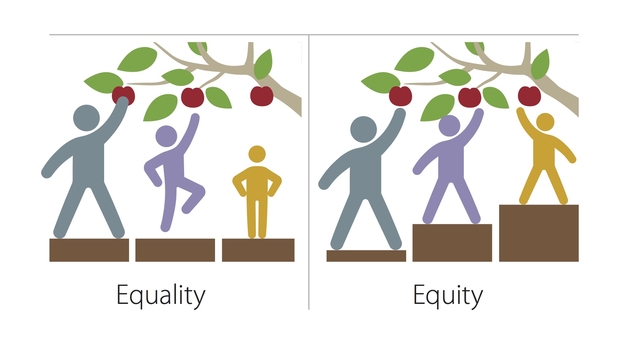
“All the rules, regulations and laws are very clear“, Mirjam said. “We need to support neurodivergent students or students with psychological variation a lot. This is an obligation to put effort into it, rather than specified rules. We need to do what is needed and necessary.“
“If you don’t get what you want, there are several possibilities for appeal and objection.“, she added. However, these things cost time and energy, and students fear the risk of repercussions, since they put themselves in a vulnerable position that might affect their assessment.
“There is still a long way to go.“, Mirjam concluded. “But the developments are positive. More and more universities are starting to be more attuned, more flexible and actually supportive.“
Mirjam’s plans for the KABK include forming working groups on this topic and implementing a buddy system, among many other things. “We have a zillion ideas and hopefully we can organise one or two of them“, she said.
She ended by citing the school’s code of conduct (page 3):
“We reject a profession that excludes, refuses to change, or is unhealthy or unkind to the people working in it. We will not treat students as though they are working in the ‚though world‘ of the arts, telling them to 'get used to it' or advising to 'prepare yourself for it now'. The purpose of art is to bring about change. To inspire. To provoke. To discover the unknown To demonstrate the desirable. We can and shall bring change to every discipline that is not inclusive, safe or healthy through the combined strength of our creativity and passion. We consider a school to be the best place to start preparing and practising for that.“
Closing words - “Let's do it!“
With this, the formal part of the evening came to a close, but guests were encouraged to continue their conversations over drinks. Willem announced that another symposium will take place on the 5th of June, to keep the momentum going that was created today. “It’s clear from this evening that we need to do this together“, he said - “So let’s do it!“
Links & Resources
Podcast where Gerard and Claudia reflect on their professional work together (in Dutch)
Blogpost about A/artist roundtable with Claudia about art education
Legal frameworks for accessible education (in Dutch)
Information on rights and obligations of educational institutions and students in Dutch or in English
Information about available support in higher education in Dutch or in English
